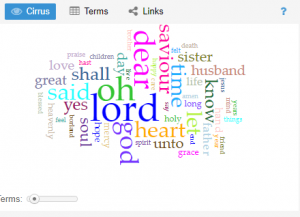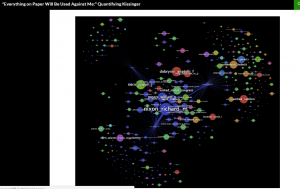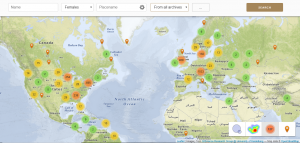


Esther Latrobe’s memoir is about her spiritual journey with God and her expression of her faith. She grew up in the early 19th century in Bristol, England and went to school in Tytherton, England. She later got married and soon died after due to childbirth. She explains in her memoir how her faith strengthened during her times of sickness.
Voyant shows the word count for the Latrobe corpus is 8,460 and 1,793 unique word forms. Those metrics are useful because they provide the vocabulary density which is 0.212. This can imply the writer’s level of education and thus socioeconomic status because an education requires time and money. In this corpus, the density doesn’t seem to be high but Latrobe talks about her faith so she uses the same expressions and phrases that are very common in Christianity. Another indicator of one’s education is the average length of one’s sentences. For example, in this memoir the average is 24.6 words per sentence. This seems longer than average which makes sense because Latrobe received an education in Tytherton. Another useful metric is keywords which tell the reader about the main ideas of a corpus. In the Latrobe memoir, the 5 main keywords are: lord, oh, dear, god and let. The most common collocates for “lord” are “pleased” and “grace” which were on the left and describe how Latrobe viewed God and her admiration for Him. The collocates for “oh” are similar to “lord” because “gracious” is one of them along with “Heavenly Father”. This shows how much Latrobe respects God and His presence in her life. For “dear”, the most common collocates are “Relative”, “Mother”, and “friends” on the right side which shows how Latrobe was a positive influence in the lives of her loved ones. The collocates for “god” are “oh” and “Lamb” on the left to describe their need for God and the well known Christian metaphor of Jesus being the Lamb of God since he is sinless and a sacrifice for Mankind. The main collocate for “let” is “me” which is used in the context of Latrobe praying to God for humility and wisdom which shows how faith played a significant role in how she wanted to live. The patterns prominent among the keywords and their collocates is that “oh”, “god”, “lord” and “let” are described with adjectives that depict God above Man and are followed by words like “me” which shows God’s authority over the one praying to Him. Another pattern the keywords share is they are in every part of the corpus, in the beginning, middle and end which emphasizes their role in expressing the memoir’s theme of Christianity and family.
The Voyant tools most commonly show the frequency of words, the context of keywords, and the relationships of words using distant and spatial reading since the tools create visualizations to help the reader understand the memoir. Franco Moretti in the Whitley reading states, “large scale patterns of publication and reception provide ‘a sharper sense of the overall interconnection’ of texts” (188). Rather than close reading, distant and spatial reading help the reader to see the theme that connects all the mains ideas of a text. Another point the Whitley reading makes is the overabundance of information technology offers makes the traditional way of “inspection, sift and synthesis” difficult because it is too mentally draining. Platforms like Voyant save the reader from wasting their time and energy (192). The reading also says, “the mind is just as capable of extracting meaning from shapes and patterns as it is at processing written language” (193).
Comparing the Latrobe memoir to Bethlehem corpus, they have keywords in common like “dear” and similar in theme like “saviour” and “sister”. Both memoirs talk about Christianity and the importance of family in their daily lives. Looking at the common key words, it seems like Christianity and family were core values for the Moravian people which is interesting to note because American culture today shares those same values but the religious aspect is more prominent in American politics than pop culture.
https://voyant-tools.org/?corpus=99820e285c977ba05ea07cb9f2c61684



